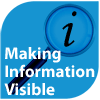 Discovering Invisible and Visible Information
Discovering Invisible and Visible Information
Jinfo Blog
13th February 2015
Abstract
Research and information management specialist, Barbara Fullerton, gives her view on tackling visibility and discovery issues; she highlights some of the content published to date in the FreePint Topic Series "Making Information Visible" as well as upcoming articles and webinars in the series.
Item
 Finding the Secret Sources
Finding the Secret Sources
When I was a child I loved writing and deciphering invisible messages. It was fun to apply heat or lemon juice to discover that the message contained a few sentences, sometimes telling me where a buried treasure was located or giving me symbols to reflect feelings. This activity reminds me that in today's world so many things in our huge data environment are difficult to see and to give meaning.
I often look for visible data that I understand, always wondering what invisible message I'm missing. And, if I have a large dataset, how can I translate my ideas into a visible message that is understandable, that contains the content needed to project a certain outcome? How can I see the "big picture" with the data I have? How do I make the invisible visible and useful?
In the Topic Series "Making Information Visible", the authors explore processes that can help provide an interactive and user-friendly representation of visible data within that "big picture" that can be used in making business decisions.
Ask the Right Questions
Constance Ard explores the processes involved in creating the "right information in the right format" in the article "Taking the Mystery out of Big Data - Moving from Data Collection to Competitive Actions". She discusses how to discover and identify the issues and create your map to display content in a visible format. She asks the important business questions:
- What do you want to address and improve to resolve problems?
- What protocols do you have in place?
Take the Right Steps
Martin White continues the evaluation of processes in his piece "Eight Steps to Good Management for Visible Information". White lists the steps needed to process the right data and the right time in the business atmosphere. With these processes in place, "competitive advantages can be achieved".
He lists the steps of the process to improve visibility as: create, store, discover, use, share, review, record, and dispose. These steps continue as an information lifecycle.
Rise to the Challenge
For some of the key visibility trends within an organisation, I highly recommend the "Q&A with InfoDesk - Visibility Within the Organisation", to be published soon. The challenges faced by organisations for explosion of big data are: tools to create visibility, protecting security, keeping statistics to prove a return on investment, and exploring content on mobile devices.
The number one challenge to organisations: all information must be kept in one place and searchable in order to use and re-use so that its data is visible.
Webinars will explore many aspects of this, such as the 18th March event "Beautiful Information is Visible Information", which will cover aspects such as examples of visualisation and how to make insights more accessible to users at all levels within the organisation. This event is open to all, thanks to sponsorship from Dow Jones.
After reading these articles, these few words sum it up for me: right data, right time, right format.
This Blog Item is part of the FreePint Topic Series "Making Information Visible".
- Blog post title: Discovering Invisible and Visible Information
- Link to this page
- View printable version
Register for our next Community session:

Team demand and AI
22nd January 2026
Latest on our YouTube channel:
Read on the Blog:
December 2025 update
3rd December 2025
- Team roles and AI (Community) 26th February 2026
- Team demand and AI (Community) 22nd January 2026
- Transforming knowledge management at BASF – GenAI and the evolution of QKnows (Community) 10th December 2025